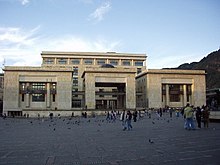Government of Colombia

The form of the government of Colombia consists of a presidential system of government as laid down in the Political Constitution of Colombia, which has been in force since July 20, 1991 . In accordance with the principle of the separation of powers in a state, the government is divided into three distinct parts: the constitutional institutions and the elected institutions.
State building
president
The President of Colombia is head of state , head of government and commander in chief of the armed forces. He is elected directly; his term of office is four years. He can be re-elected once. The president appoints and dismisses the cabinet. Its official seat is the Casa de Nariño .
congress
The two chambers of the Congress are also elected for four years. The members of the Senate , in which there are a total of 102 seats, are elected from nationwide lists. The House of Representatives, with a total of 166 members, consists of representatives from the provinces called Departamentos ; List elections are also held in the individual provinces. The country is divided into 32 provinces, plus Bogotá as Distrito Capital. Governors, mayors, regional parliaments and city or town councils are elected directly and for four years. The tasks of the provinces mainly cover the economic and social development of their local authorities and administrative issues.
Judiciary
The judiciary is independent. The judiciary is headed by the Corte Suprema de Justicia de Colombia , the Supreme Court. This consists of 23 judges who work in three different chambers (the criminal chamber, the agricultural chamber and the labor chamber). The jurisdiction also includes the Council of State ( Consejo de Estado de Colombia ). He has a special responsibility for the laws regarding the administration and gives the executive legal advice. The Corte Constitucional de Colombia , the constitutional court, pays attention to the integrity of the Colombian constitution and the so-called Supreme Council of Justice , ( Consejo Superior de la Judicatura ) is responsible for the supervision of the entire jurisdiction . The Republic of Colombia works with a system of civil laws that has been in place since 2005 through what is known as an " adversarial procedure ".
Parliamentary elections
In the parliamentary elections held in March 2014, the Social Democratic Partido Liberal Colombiano won the most seats in the House of Representatives and the pro-government Partido Social de Unidad Nacional in the Senate. A new factor is the Centro Democrático party of ex-President Álvaro Uribe , who appeared for the first time and entered the Senate with 20 seats (out of 102) . In the presidential election held in May / June 2014 , Juan Manuel Santos Calderón was confirmed as President of the Republic. He started his second term on August 7, 2014. The next parliamentary elections will take place in spring 2018.
Individual evidence
- ↑ CONSTITUCION POLITICA DE COLOMBIA 1991 . bq-portal.de. Accessed March 6, 2017 (Spanish)
- ^ Colombia: Political System . goruma.de. Accessed March 5, 2017
Web links
- Government in Colombia
- Political System in Colombia Bertelsmann Stiftung, accessed March 5, 2017
- Asambleas constituyentes (Spanish)

